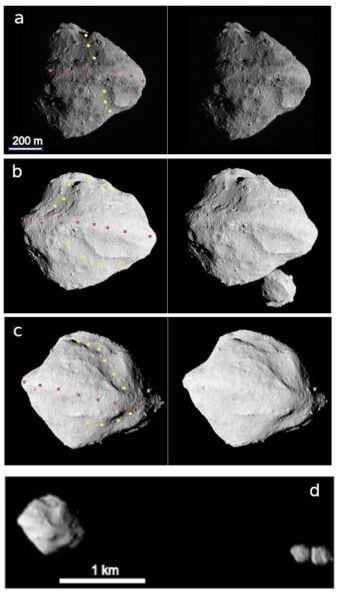NASA’s Lucy spacecraft has made a surprising discovery during its flyby of asteroid Dinkinesh, also known as “Dinky,” in November 2023. The mission team, which includes University of Maryland Professor of Astronomy and Geology Jessica Sunshine, found that Dinky was not alone in space but was accompanied by a satellite asteroid named “Selam.” As more data from the spacecraft arrived on Earth, the researchers realized that Selam was not just a single moon but a contact binary, consisting of two moons fused together.
The Lucy team detailed their unexpected finding in a paper published in the journal Nature on May 29, 2024. They noted that this unusual arrangement challenges existing theories about the formation of asteroids and other celestial bodies over time. The discovery also provides additional insight into the internal structure, dynamics, and evolutionary history of both Dinky and Selam.
Unveiling the Complexity of Small Celestial Bodies
Professor Sunshine, a co-author of the paper, emphasized that the study reveals a higher level of complexity in small celestial bodies than previously thought. “With the additional observations taken by the spacecraft, we were able to better analyze features such as Dinkinesh’s rotation speed and Selam’s orbit pattern. We also have a better understanding of what materials they’re possibly made of, bringing us a step closer to learning just how terrestrial bodies are created,” she said.
Images captured by the Lucy spacecraft showed a trough on Dinkinesh where about a quarter of the asteroid had broken off from its main body, a ridge that formed after the asteroid’s structural failure, and the contact binary now known as Selam. The team hypothesized that Dinky’s rapid spinning motion, amplified by the uneven reflection of sunlight off the asteroid’s surface, caused it to shed and eject rocky debris into orbit. Some of this debris may have aggregated to form Selam, while another portion of the fragments fell back onto Dinky as boulders, creating the ridges seen in the spacecraft’s photographs.
Understanding the Formation of Planets
Lead scientist Hal Levison of Southwest Research Institute, Boulder, Colorado, and principal investigator for the Lucy mission, emphasized the importance of understanding how objects behave when they collide in order to comprehend the formation of planets like Earth. “Basically, the planets formed when [smaller objects like asteroids] orbiting the Sun ran into each other. Whether objects break apart when they hit or stick together has a lot to do with their strength and internal structure,” he explained.
The team deduced that Dinky likely had some internal strength, which allowed it to maintain most of its form. However, the exact process by which Dinky’s unusual dual moons formed remains a mystery. Professor Sunshine noted that the team’s findings open the door to comparative studies with similar celestial bodies, such as the Didymos binary system, which shares many similarities with the Dinkinesh system despite being located in different parts of the solar system.
Dinkinesh and its satellite are the first two of 11 asteroids that Lucy plans to explore over its 12-year journey. After observing asteroid Donaldjohanson in April 2025, the spacecraft will move on to study the Trojan asteroids in 2027.
“Our ultimate goal is to understand the formation of celestial bodies,” Sunshine said. “How do planets form? How was Earth formed? We know that big planets are formed by smaller bodies, so studying these little asteroids lets us see how materials behave and interact on a smaller scale. With Dinky and the other asteroids we’re flying by, we’re laying the groundwork for understanding how planets are made.”
If our reporting has informed or inspired you, please consider making a donation. Every contribution, no matter the size, empowers us to continue delivering accurate, engaging, and trustworthy science and medical news. Independent journalism requires time, effort, and resources—your support ensures we can keep uncovering the stories that matter most to you.
Join us in making knowledge accessible and impactful. Thank you for standing with us!

